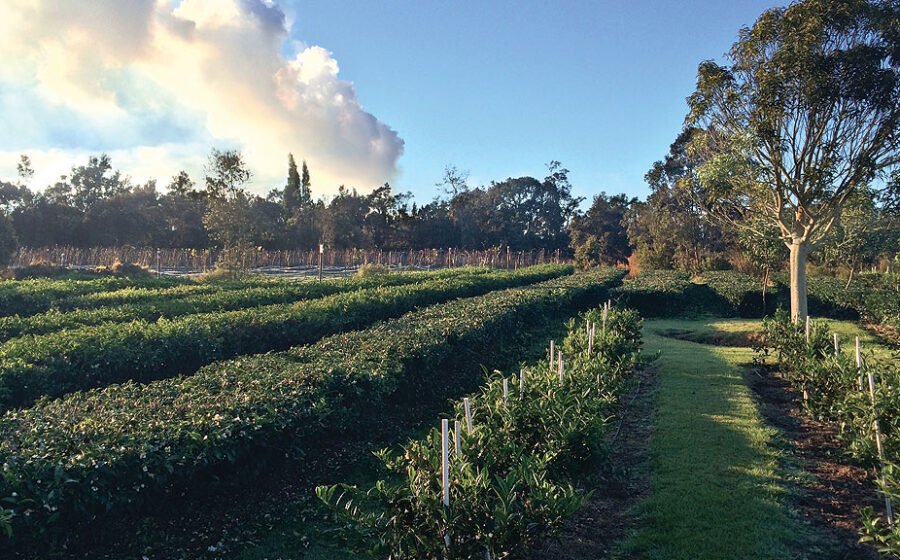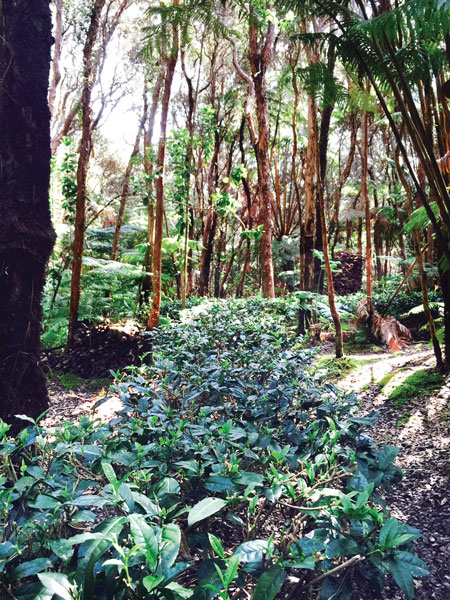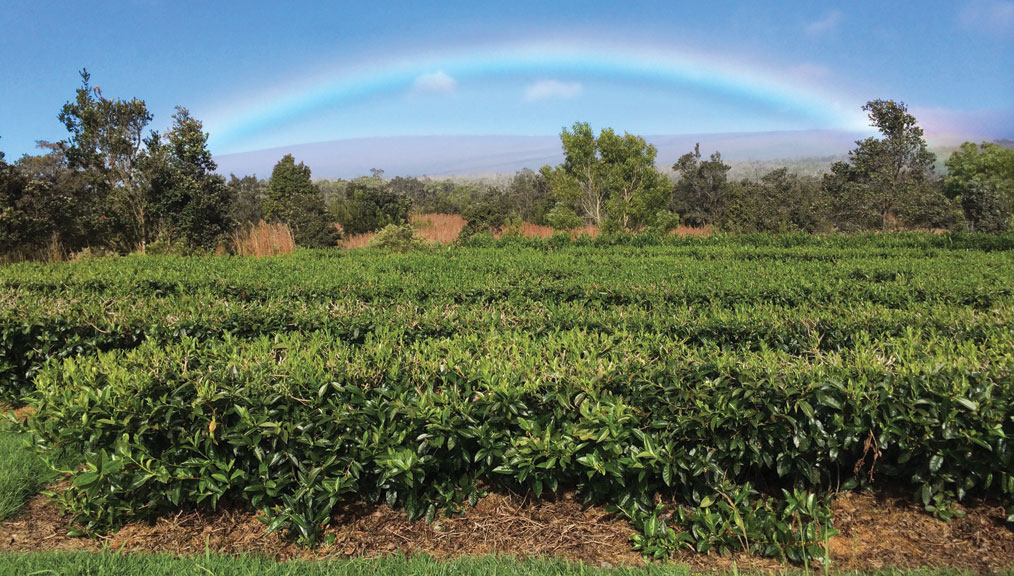[T]ea is not the first thing that comes to mind when we think of Hawaii’s isolated archipelago, though many people have looked at the islands and imagined it reaching high on that list. Straddling the Tropic of Cancer, the islands’ location, favorable maritime weather systems, and rich volcanic soils are hard to argue with as an ideal terroir for our favorite plant.
Tea is not a new plant to Hawaii. Experimental plantings date back to 1887, around the time the very first tea plants were arriving in Africa. In 1892, the Hawaiian Coffee and Tea Company planted five acres of tea plants in Kona. But even at the end of the nineteenth century, despite a favorable growing environment, the cultivation and manufacture of tea was too labor intensive and failed to survive as a viable cash crop. The cost of producing tea in the Hawaiian economy could not compete with the rapid establishment of competitive, large-scale plantation economies in Asia and Africa. Coffee, at fewer man-hours per pound, enjoyed much greater success on the islands.
Tea production went quiet for nearly a century. During that time, the sugar industry changed the face of the islands with large-scale imported labor and heavy, often irreparable, environmental damage. The state’s largest sugar companies—known as the Big Five—operated as traditional plantations and began feeling the pinch of labor rights and changing markets during the first half of the twentieth century. In 1959, as Hawaii was granted statehood, the labor conditions and wages became untenable, tipping the advantage toward growing sugar cane outside of the state. As Hawaii’s sugar industry decayed during the 1960s, several of the Big Five looked into alternative crops before investing their money and efforts into the rapidly expanding tourist industry, which became the base of the islands’ new economy. Tea was among the experiments. Alexander and Baldwin, known as A&B, even joined forces with Thomas J. Lipton Co. in the eighties and early nineties and planted some test fields of tea. But tea still could not compete with the necessary market prices to flourish in Hawaii. A frustrating situation for a happy plant that was a commercial non-starter.
Though by no means the first person to introduce Camellia sinensis to the friendly soils of the islands, horticulturist Francis Zee is, in many people’s minds, the founding father of Hawaii’s modern tea farming movement. His name crops up regularly in conversations and is always spoken with reverence. In 2000, this zealous USDA scientist, who works with the Pacific Basin Agriculture Research Center, was convinced of tea’s great potential in the islands. With studies and papers on the subject, and a pitch built on the expanding market for specialty tea and the ideal growing conditions, he managed to gain some project funding.
In need of manpower and land for his initial plantings, he wisely tapped into the many enthusiastic gardeners of the Big Island. Posting an ad in the local newspaper, he offered all the seed stock and training prospective farmers might need to get a plot of tea started and manufacture their own finished leaf. The response was very positive. This was an important milestone in Hawaii’s tea story—the emergence of a new format for tea production on the islands. By tapping into the passion and focus of these artisanal growers, Zee initiated an industry based on the pleasure of growing plants and transforming the leaf into artisanal teas.
This new setup placed tea far from the regular restraints of plantation dynamics and the stresses of economic viability. For a population familiar with the environmental destruction of the sugar giants, this innovative project suited the Hawaiian grass roots, local-grown, and environmentally friendly set of values. The current structure of this industry, in as much as it is an industry, is a far cry from the economies of scale that the traditional tea world uses to make things work.
Traveling around the islands, one soon realizes how hard it is to generalize about the Hawaiian terroir. In fact, it is hard to imagine such a small region packed with such diversity.
Most tea farmers grow other crops so they are not solely dependent on tea production. Tea is usually a side venture. Many growers I spoke to had an annual production between fifty and 100 kilograms of finished leaf; others, even less. To put that in perspective: large gardens in Assam will push out well over 50,000 kilos of finished tea a day, support tens of thousands of workers, and sell their wares at well below ten dollars per kilo. The equation works differently in this new model. Aside from a few small contracts with Harrods- or Fortnum-and-Mason–style tea stores, it seems that much of the tea is sold to the hordes of tourists visiting the island every year, nicely packaged as a locally grown little taste of paradise. Just a few grams of loose artisanal leaf make a perfect gift for any traveling epicurean or tea lover. So a small annual supply of fifty kilograms at prices of anything up to a dollar per gram achieves an unconventional form of economic balance.
Traveling around the islands, one soon realizes how hard it is to generalize about the Hawaiian terroir. In fact, it is hard to imagine such a small region packed with such diversity. Many of the volcanoes that created this string of islands in the middle of the ocean are still at work. The islands to the north have settled geologically, but down on the Big Island, where the highest concentration of tea growers is located, the map is striped by vast lunar landscapes of fresh lava fields flowing from the mountains to the sea. Once the lava cools, life slowly blows in and lodges into the cracks and crevices of the lava, and the cycle starts again from scratch. Progressive generations of growth and decomposition that produce topsoil begin. Between these flows are geographically protected patches called kipuka where the rich tropical soil stacks four or five meters deep.
Hawaii’s islands possess large variations in altitude. The highest peak is Mauna Kea at a monumental 4,207 meters (13,803 feet). Many farms in the volcano area are around 1,500 meters (about 5,000 feet) above sea level. The tropical maritime precipitation systems passing over these tall peaks tend to burst due to the rain-shadow effect on one side of the mountain, giving vastly contrasting regions of dry and wet in a small area. From these mountain conditions it is only a short distance to warmer coastal gardens that take weather straight off the ocean. With such a rich diversity of soils, minerals, and microclimates, the focus of each grower differs slightly.
Nobody knows how many growers are active in the islands, as they tend to keep to themselves, but estimates range from forty to sixty, though many of these have just a small plot of plants. As this league of gardeners slowly evolved after 2000, new seed stock was carefully introduced from China and Japan. The cultivars bohea, yabukita, yutaka midori, and benikaori were then followed by private imports from Darjeeling, Assam, Pakistan, and cing shin from Taiwan. Naturally the diversity of the terroir requires a good range of cultivars to suit all these growing environments. Careful control of such imports has been generally respected as Hawaii is relatively pest free compared to most growing regions and every import of plant material holds the risks of importing tea-specific insects and diseases.
As each plot of tea develops, most growers plant a variety of cultivars. The College of Tropical Agriculture and Human Resources planted a couple of test fields in Mealani and Volcano to test a selection of these plants. Increasing numbers of growers are opting for a certain amount of seed propagation to strengthen the strains and build reliance. Over the years, guidance from specialists from Asia has also been offered to help with manufacture. Though some still use a very unusual microwave technique suggested by Francis Zee in the early days, most are using some form of hot pan or small Taiwanese style rollers and dryers. Teas of all styles are manufactured: white, green, black, and a large amount of oolong.
Last November, the first Tea of the United States Awards, founded by Eva Lee, was held in Volcano Village on the Big Island, just over fifteen years after Zee made his call for volunteers. Entries and winners represented several states, but most of the teas were from the islands. TOTUS created a great spotlight for the progress that has been made in Hawaii and a platform to voice the presence and needs of growers to the state.
The potential for quality tea here is impressive. Proper training and incentives are essential to nourish this potential, to retain the initial enthusiasm for tea growing, and to create a structure for growth and stability. The growers would strengthen their collective voice through some form of association. A bill is currently working through the state senate to create a recognized geographical indication similar to those of many other tea regions; TOTUS is cited throughout the bill as a reason for creating this designation. The efforts to officially designate the region also address desires to create a brand synonymous with superior quality; growers want Hawaiian-grown tea to be distinguished from inferior Hawaii-branded products that have little or no connection to the islands.
The Hawaiian tea industry is young—less than twenty years in the making. Even so, it has achieved a self-contained balance. But the potential to expand is apparent. Not just to make larger quantities (that is not the answer to everything), but to present itself in a more practical and price-friendly way to the growing specialty tea market. Outside a captive tourist clientele, charging a dollar for a gram of tea requires something extraordinary; to become more than a one-sale deal, the Hawaiian teas will have to guarantee a tasting experience to remember.
But the tea lover in me sees something else. Naturally rich soils, exceptional weather conditions, lack of pests, and plenty of sunshine hours are a paradisiacal scenario. Add to that a league of small-scale, passionate tea farmers who have the patience for quality artisanal work. Everything is in place here for the right things to happen. This fresh fascination for the plant, its cultivation and manufacture, untethered by the traditions of established origins, make Hawaii a perfect place to test a new model for tea.
What better way to start an industry?
—Kevin Gascoyne is part-owner of Camellia Sinensis and co-authored Tea: History, Terroirs, Varieties.











